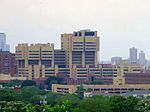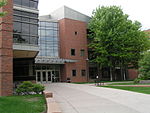M Health Fairview University of Minnesota Masonic Children's Hospital
Buildings and structures in MinneapolisChildren's hospitals in the United StatesHospitals established in 1986Hospitals in Minnesota

M Health Fairview University of Minnesota Masonic Children's Hospital (formerly known as Amplatz Children's Hospital) is a non-profit pediatric acute care hospital located in Minneapolis, Minnesota. The hospital has 212 beds and is affiliated with University of Minnesota Medical School. The hospital provides comprehensive pediatric specialties and subspecialties to pediatric patients aged 0–21 throughout Minnesota and midwest United States. Masonic Children's Hospital is also a state designated Level III Trauma Center.
Excerpt from the Wikipedia article M Health Fairview University of Minnesota Masonic Children's Hospital (License: CC BY-SA 3.0, Authors, Images).M Health Fairview University of Minnesota Masonic Children's Hospital
Riverside Avenue, Minneapolis Phillips
Geographical coordinates (GPS) Address Phone number Website Nearby Places Show on map
Geographical coordinates (GPS)
| Latitude | Longitude |
|---|---|
| N 44.967222222222 ° | E -93.2375 ° |
Address
University of Minnesota Medical Center - West Bank Campus
Riverside Avenue
55454 Minneapolis, Phillips
Minnesota, United States
Open on Google Maps









